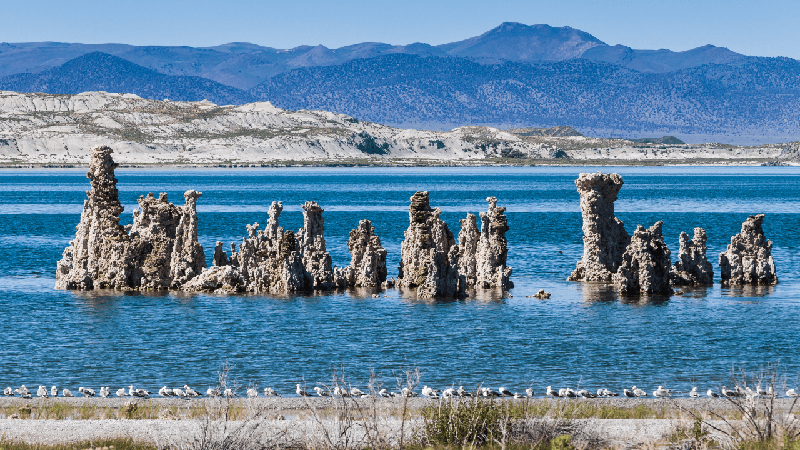
Withholding a mere 1% of LA's water would protect Mono Lake and millions of birds. Photo by Oscity, Shutterstock
By Martha Davis special to CalMatters
In 1994, I stood at a crowded dais in Sacramento where the city of Los Angeles and Los Angeles Department of Water and Power, or DWP, joined the Mono Lake Committee and many others to support the State Water Board’s landmark decision to save Mono Lake.
For California, the historic announcement ended two decades of litigation over the DWP’s environmentally devastating diversion of water away from Mono Lake.
The 1994 decision was intended to benefit Mono Lake, an extraordinary ecosystem located east of Yosemite National Park. This million-year-old lake is one of the nation’s most important shorebird habitats, internationally recognized as an essential stop on the Pacific Flyway for millions of migratory birds.
The water board directed the DWP to divert less water from the basin so that Mono Lake would reach an elevation of 6,392 feet above sea level. The compromise was considered strong enough to protect Mono Lake’s health. The state and federal government also made over $100 million available to fund water conservation and recycling programs to help offset the water DWP ceded.
Fast forward 29 years: Mono Lake was saved, right?
Unfortunately, no. California has experienced more erratic rainfall than anyone envisioned almost three decades ago. As DWP diverted the maximum allowed by the water board, Mono Lake bore the brunt of drought shortages.
As a result, Mono Lake rose about four feet – leaving the lake 13 feet below the water board’s mandated level.
Even with winter’s remarkable rainfall, Mono Lake will not rise enough to reduce unhealthy dust storms that billow off the exposed lakebed and violate air quality standards. Nor will it offset increasing salinity levels that threaten Mono Lake Kutzadika’a tribe’s cultural resources and food for millions of migratory birds.
Any gain Mono Lake makes surely won’t last due to the DWP’s ongoing diversions. In fact, Mono Lake is now so low that coyotes could once again access islets where California gulls nest and decimate the population.
Last month the water board held an informational workshop on Mono Lake’s dire condition. The California Department of Fish and Wildlife and the Kutzadika’a tribe joined the lake committee in requesting emergency action to suspend DWP diversions this year–a meager 4,500 acre-feet or 1% of L.A. water use–to keep as much water in Mono Lake as possible. The water board’s decision is pending.
Los Angeles and Mono Lake share a problem – they both need an adequate and reliable water supply. But they also share a common solution, seeking available state funds for additional water conservation, especially for programs that save water and reduce utility bills for residents who can least afford rate increases.
The DWP has instead argued that Mono Lake is “fine” at its current, low level. They claim the 1994 decision is “aspirational,” not binding.
The department also says that low-income ratepayers will be hurt if diversions are reduced. Yet last year, when the Mono Lake Committee repeatedly asked DWP to join in requesting state money to help Los Angeles residents and Mono Lake, the department refused.
What DWP doesn’t mention is the 1994 funding that bolstered conservation programs also contributed to ratepayer savings of more than $11 billion over a 15-year period, a 2018 study by the Alliance for Water Efficiency found. Also missing is this alarming fact: DWP has received tens of thousands of acre-foot more water under the 1994 decision than anyone, including the water board, expected, according to a Mono Lake Committee analysis.
Effectively, DWP is saying: heads, DWP wins; tails, Mono Lake loses. The department can take all the water the 1994 decision allows and accept government funding to conserve and develop local supplies when it suits them. But if the water board’s order didn’t save Mono Lake – well, that’s not DWP’s problem.
Really? Is that what Los Angeles meant when the city jointly pledged with the lake committee and others to raise and protect Mono Lake?
If DWP won’t voluntarily cooperate in finding a way to protect Mono Lake, then the State Water Board needs to step up and save Mono Lake – again.
Martha Davis is a board member for the Mono Lake Committee and served as executive director from 1983-1996. She is the former assistant general manager for policy development at the Inland Empire Utilities Agency.
CalMatters.org is a nonprofit, nonpartisan media venture explaining California policies and politics.
Articles which extol the virtues of a report or article put out by a local newsroom.